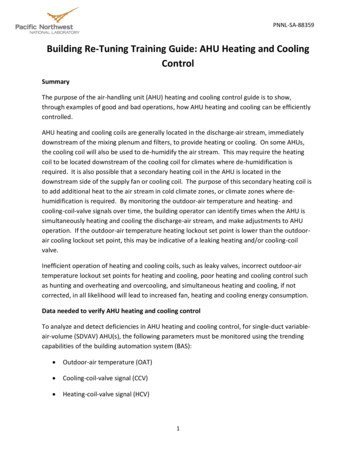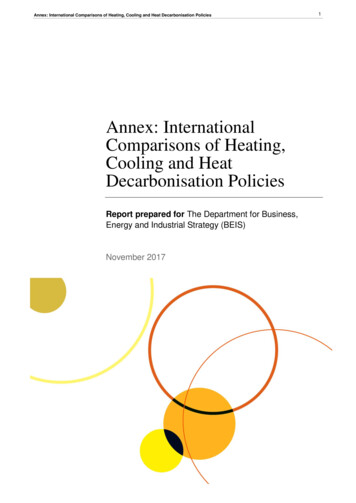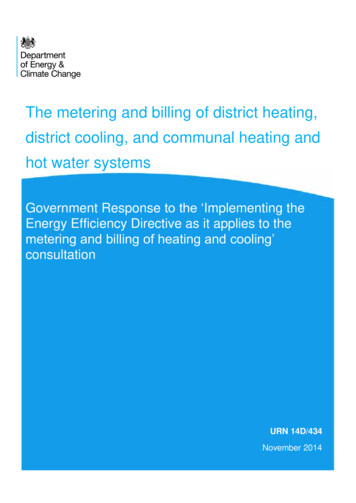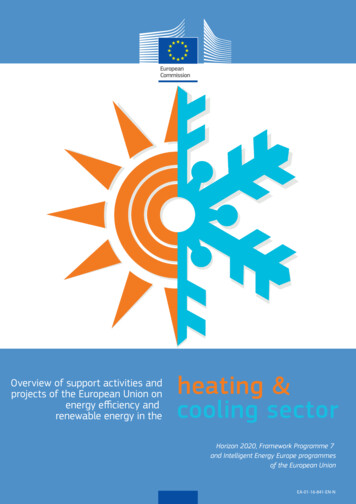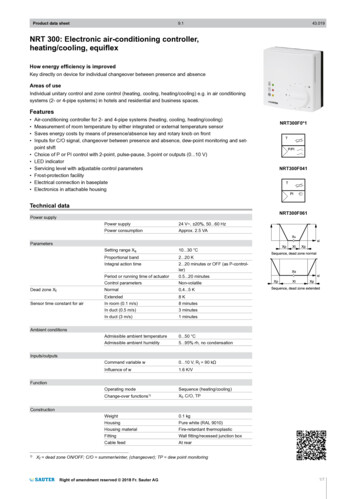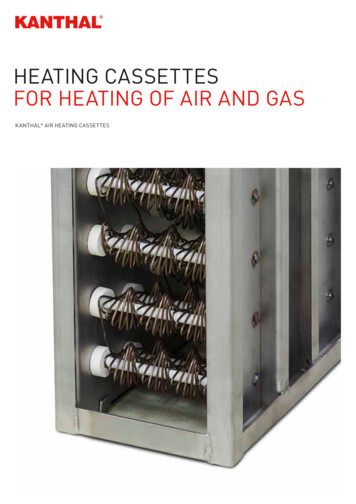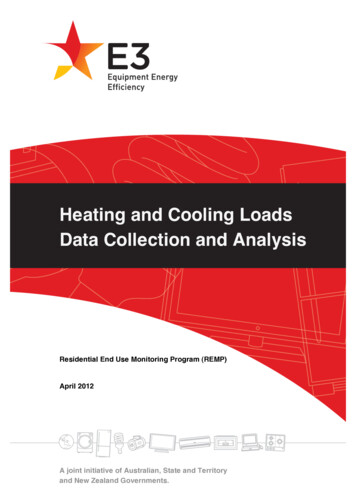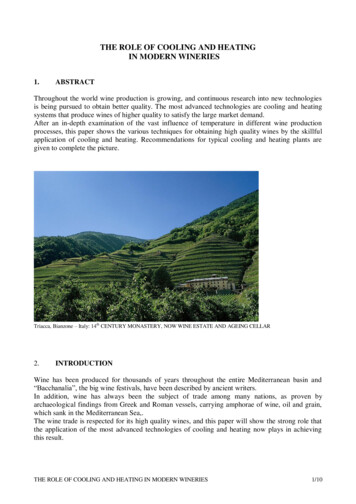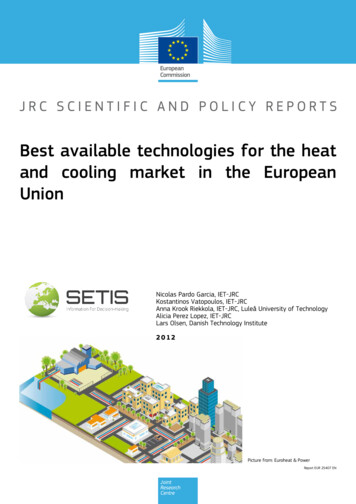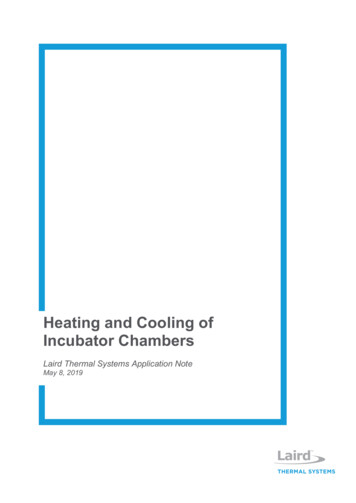
Transcription
Heating and Cooling ofIncubator ChambersLaird Thermal Systems Application NoteMay 8, 2019
IntroductionIncubators, used for cell and tissue cultivation in hospital and laboratory settings, grow andmaintain cell and tissue samples under controlled conditions for hours, weeks, or evenmonths. They create the ideal environment for cell and tissue sample growth by maintainingoptimum levels for temperature, humidity, carbon dioxide, and oxygen. Precision control ofthese factors enables research and experimental work in industries where cell culture is vital,such as zoology, microbiology, pharmaceutical research, food science, and cosmetics.Accurate and precise control of temperature is especially important for cell growth.Excursions above and below the optimum mammalian body temperature of 37 C, even byas little as 6 C, negatively impact cell health. If too cold, growth slows, sometimespermanently; if too hot, sensitive proteins begin to denature.Using compact Peltier thermoelectric assemblies (TEAs) instead of compressor-basedthermal management solutions provide a more efficient and cost-effective option. In addition,new government restrictions of traditional and natural refrigerants central to compressorbased systems make thermoelectrics a more advantageous solution for temperaturestabilization in incubators.Incubator RequirementsControl of temperature, humidity, carbon dioxide,and oxygen levels must be maintained in theincubators for proper cell culture to occur. The heatload requirements can range from 30 to more than400 Watts based on chamber size. For CO2incubators, relative humidity levels of 95 to 98percent and specified CO2 concentrations rangingfrom 0.3 to 19.9 percent also must be maintained.Design ChallengesIncubator manufacturers face many thermal management design challenges ranging fromspace constraints, airflow, moisture, and dust, to ease of cleaning.Tight space constraints within incubators require thermal control units to have a compactform factor, maximizing chamber volume. The thermal solution must include an efficient,effective heat exchanger/fan, operating within limited space. Achieving heating and coolingwithin this limited volume requires units with high heat-flux densities.The second challenge is ensuring consistent airflow throughout the chamber. Incubatorsfeature fans or blowers with baffles to distribute air gently and evenly over the samples.However, fans and other components must be protected from moisture and humidity, whichcan cause corrosion that quickly degrades the performance of mechanical components likefans. It can be difficult, however, to balance the high humidity levels needed for properoperation of the incubator with condensation forming inside the unit. Features such asgasket sealing, potting—or even more advanced sealing options—will eradicatecondensation leakage.Finally, from an operational standpoint, dust may be a concern. Depending on lab activityaround the incubator and air quality, dust can accumulate in the fan/heatsink assembly,increasing thermal resistance, thereby reducing performance. To maintain good thermalperformance and longer incubator life, keep all obstructions away from the air inlet, and filterall incoming air. The incubator design also must account for biohazard safety protocols byincorporating easy-to-clean and -sterilize interiors and shelves.2
Traditional SolutionsTypically, in a CO2 incubator, an air or water jacket maintains an even temperature. Sincewater has a much greater specific heat than air, water temperature changes much moreslowly, thereby regulating the temperature inside the lab incubator. The water jacket, awater-filled casing surrounding the incubator, has inlet and outlet ports which circulate waterthrough the chamber walls and to an external heating and/or cooling device. The waterexchanges heat with the inner chamber via natural convection and provides a fairly uniforminterior temperature and thermal buffer against outside air. The down side is water jacketsmay leak; and since they contain a significant volume of water, they are very heavy andusually need to be emptied before moving. After moving, the refill and restart processrequires about 24 hours to return to a stable operating temperature, leading to significantdowntime.Using a similar casing to the water design, an electric coil or compressor-based systemheats air within the jacket, which radiates heat directly to the cell cultures. Some air-jacketedmodels rely strictly on natural convection to distribute heat evenly inside the chamber, whileothers add fans. Forced convection, however, increases evaporation from the cultures,desiccating small samples, even when adding a humidity pan. In addition, compressorbased air jackets add unwanted vibration and noise to the lab environment, while generallyoccupying a large amount of space.Recent government regulations banning the use of specific refrigerants, particularly inEurope, are motivating incubator manufacturers to look at solid-state thermoelectrictemperature control systems as an alternative to compressor-based systems. Oldercompressor-based systems utilize high global-warming-potential HFC refrigerants includingR134a and R404A. Modern compressor-based systems now use a variety of naturalrefrigerants: R744 (carbon dioxide), R717 (ammonia), R290 (propane), R600a (isobutene),and R1270 (propylene). Each natural refrigerant, however, presents design challenges suchas increased pressure, high toxicity, flammability, asphyxiation, and relatively poorperformance. The flammable nature of some natural refrigerants makes them hazardous totransport.Peltier Heating/CoolingEnvironmentally friendly Peltier temperature control systems offer accurate and preciseheating and cooling inside the chamber, keeping samples safe from temperature changes.The many advantages of using thermoelectric assemblies for incubator thermalmanagement include both cooling and heating modes, precise temperature control, rapidcool-down or heat -up ramp rates, and a compact form factor. All of this is accomplishedwithout the use of any refrigerants—natural or synthetic.Thermoelectric assemblies use solid-state heat pumps known as thermoelectric modules(TEMs) or thermoelectric coolers (TECs). Via the Peltier effect, these thermoelectricmodules can move heat from a low temperature to a higher temperature to either cool orheat depending on sample placement. When DC current flows through the TEM, one sidegets hot, while the opposite side gets cold. If you reverse the direction of current flow, thenthe two sides reverse their function. Manufacturers of thermoelectric modules define twospecifications for thermoelectric coolers: ΔTMax and QcMax. ΔTMax is the maximum temperaturedifferential with no heat flow (Qc 0). QcMax is the maximum heat flow when no temperaturedifference exists (ΔT 0). For most single-stage modules, ΔTMax hovers near 70 C.However, a lot of this temperature differential can be lost thru thermal resistances of heatsinks. If greater cooling capacity is demanded, then more thermoelectric modules arerequired. This can be done by wiring TEMs in series or parallel to accommodate 12 or 24VDC. Real-world operation of thermoelectric modules and thermoelectric assemblies3
involves the combination of ΔT and Qc to meet incubator heating and cooling requirementsfor temperature stabilization.The combination of a closed-loop temperature controller with a thermoelectric assemblycreates a highly responsive, accurate and precise thermal management system. Atemperature controller, specifically designed tocontrol thermoelectric assemblies, takes feedbackfrom a temperature sensor to vary the output of thepower supply to control the temperature of anenclosure. Temperature controllers canaccommodate a variety of control options to deliverenergy savings and offer safety alerts. I/O contactsare available for fans, thermoelectric modules,alarm/status LEDs, thermistors, fan tachometersensors, and an overheat thermostat.Laird Thermal Solutions for IncubatorsLaird Thermal Systems produces a wide array of thermoelectric assemblies and temperaturecontroller combinations optimized for this application. Any one of the SuperCoolThermoelectric Assembly series outfitted with a SR-54 or PR-59 temperature controlleroffers significant design advantages over traditional technologies. All of the SuperCool seriesfeature a high-performance heatsink design, incorporating heat pipes to improve heatdissipation and fan shroud assembly. Lowering the thermal resistance of the heat exchangerincreases the heat-pumping ability, so these thermoelectric assemblies can operate at ahigher coefficient of performance (COP), reducing power consumption relative to competingtechnologies. All this capability is packed into a compact form factor.The SuperCool Series gives design engineers three different heat transfer mechanisms withthree standard thermoelectric assemblies: Liquid-to-Air, Direct-to-Air, or Air-to-Air. Theseassemblies offer cooling capacities of 166, 193, and 202 Watts, respectively, whenmeasured at ΔT 0 C with a nominal operating voltage of 24 VDC. They can be easilymounted onto vertical walls using fastening machine screw hardware.SuperCool Series: SAA-170-24-22, SDA-195-24-02, SLA-205-24-02For temperature control, the SR-54 programmable microcontroller provides thermal stabilityto within 0.13 C of the set point in both heating and cooling modes. The SR-54 allows theincubator to reach the set-point temperature quickly without overshooting. Its monitoringcapabilities track potential issues, including problematic fans, thermoelectric modules, andthermostats for quick fault troubleshooting, maximizing incubator uptime. Variable fan speedreduces operational noise, since the fans only run on high speed during the initialtemperature ramp and then lower their speed when the incubator temperature has reachedsteady-state.4
Another option is the PR-59 temperature controller with power regulation that is selectableand user-configurable for PID (proportional-integral-derivative), thermostat ON/OFF, orPOWER, protecting equipment and optimizing performance. The PR-59 programmablemicrocontroller delivers control stability to within 0.05 C of the set point in both heating andcooling modes. By connecting to a PC with associated software, temperature set points andother parameters can be selected.SR-54 and PR-59 Temperature ControllersLaird Thermal Systems can customize thermoelectric assembly solutions based on specificapplication needs. Customers usually begin with a standard thermoelectric assembly andadjust the form factor by modifying heat sinks, mounting locations, and air flow passages towork around obstructions. Barrier protection around TEM cavity prevents condensationissues from impacting thermoelectric assembly operation. Laird Thermal Systemsunderstands how to modify designs to boost performance or efficiency, optimizing for thedesired thermal-management effect. Many years of experience have stocked a large librarywith reference designs for similar applications, enabling quick response with new customdesigns.ResultsUsing thermoelectric assemblies for incubator temperature control, rather than traditionaltechnologies, achieves an efficient, thermally stable, compact, reliable, low-maintenance andlow-cost-of-ownership solution to CO2 incubator thermal management.Thermal Systems can partner closely with customers across the entire product developmentlifecycle to reduce risk and accelerate time to market. Depending on the customer needsthey can provide various levels of vertical integration. Some customers purchase LairdThermal Systems’ thermoelectric assemblies and build their own custom solutions whileother design their own solutions and use Laird Thermal Systems as a contract manufacturerto build them. Still, others prefer the entire solution, from design to manufacturing.5
About Laird Thermal SystemsLaird Thermal Systems develops thermal management solutions for demanding applicationsacross global medical, industrial, transportation and telecommunications markets. Wemanufacture one of the most diverse product portfolios in the industry ranging from activethermoelectric components and assemblies to temperature controllers and liquid coolingsystems. Our engineers use advanced thermal modeling and management techniques tosolve complex heat and temperature control problems. By offering a broad range of design,prototyping and in-house testing capabilities, we partner closely with our customers acrossthe entire product development lifecycle to reduce risk and accelerate their time-to-market.Our global manufacturing and support resources help customers maximize productivity,uptime, performance and product quality. Laird Thermal Systems is the optimum choice forstandard or custom thermal solutions. Learn more by visiting www.lairdthermal.comContact Laird Thermal SystemsHave a question or need more information about Laird Thermal Systems? Please give us acall or contact via the web.America: 1 919 597 7300Europe: 46 31 420530Asia: 86 755 2714 S-CO2-INCUBATOR-APP-NOTE-LT1432 2019 All rights reserved. Laird, Laird Technologies and the respective logos are trademarks owned by Laird PLC and/or LairdTechnologies Inc., either directly or indirectly through one or more subsidiaries. Other products, logos, and company namesmentioned herein, may be trademarks of their respective owners.6
to within 0.13 C of the set point in both heating and cooling modes. The SR-54 allows the incubator to reach the set-point temperature quickly without overshooting .Its monitoring capabilities track potential issues, including problematic fans, thermoelectric modules, and thermostats for quick fault troubleshooting, maximizing incubator uptime.
